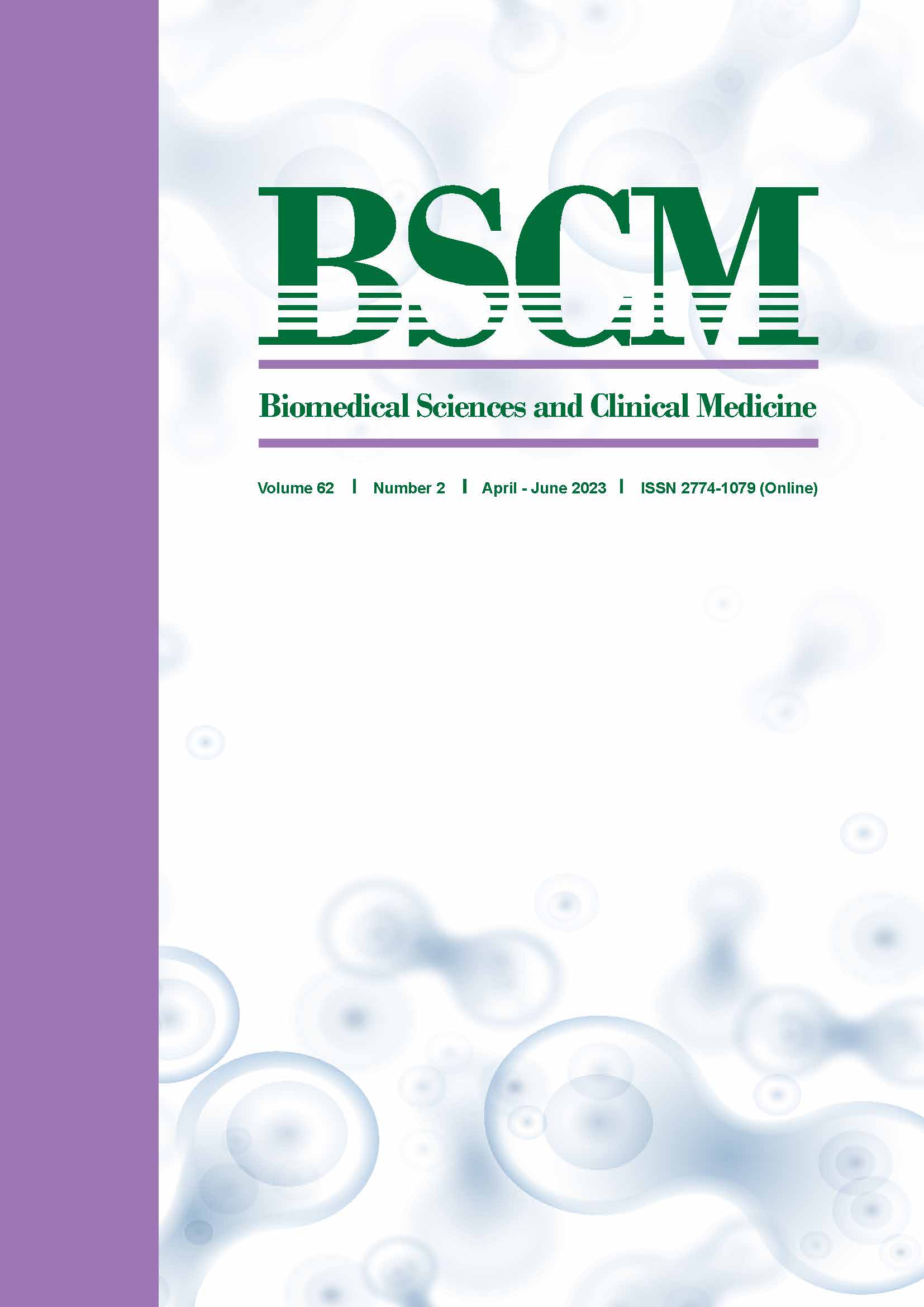Expression of Heat Shock Protein 30 in Talaromyces marneffei during Phase Transition and in Response to Heat and Oxidative Stresses
Main Article Content
Abstract
Objective Heat shock protein 30 (Hsp30) has been identified as an immunogenic, yeast phase-specific protein in Talaromyces marneffei. The purpose of this study was to investigate how the hsp30 gene and Hsp30 protein are expressed during phase transition and in response to heat and oxidative stress exposure.
Methods Several sequence analysis tools were employed to predict hsp30 control elements and to determine the subcellular localization of Hsp30. In the phase transition experiment, Talaromyces marneffei conidia were cultivated at two different temperatures, 25 °C and 37 °C. Subsequently, stress response tests were conducted by subjecting the yeast cells to heat at 42 °C and by treating them with hydrogen peroxide. The levels of the hsp30 transcript and its protein were measured using real-time RT-PCR and western immunoblot analysis, respectively.
Results The sequence analysis revealed the presence of heat response element (HRE), stress responsive element (STRE), and xenobiotic responsive element (XRE), which are typically involved in regulating hsp genes. A web-based tool predicted that Hsp30 protein is localized in cytoplasm, nucleus, and cell membrane. The hsp30 transcript and Hsp30 protein were highly clearly detected in both yeast cells and conidia. Furthermore, the hsp30 transcript in yeast cells was upregulated following heat shock at 42° C and exposure to hydrogen peroxide. These findings indicate that Hsp30 plays a crucial role in assisting the yeast phase of T. marneffei to cope with heat and oxidative stresses.
Conclusions Hsp30 is a protein specific to the conidial and yeast phases of T. marneffei. It likely performs a conserved chaperone function during yeast growth and plays a significant role in stress response by mitigating protein aggregation issues.
Article Details

This work is licensed under a Creative Commons Attribution 4.0 International License.
References
Boyce KJ, Andrianopoulos A. Morphogenetic circuitry regulating growth and development in the dimorphic pathogen Penicillium marneffei. Eukaryot Cell. 2013;12:154-60.
Supparatpinyo K, Chiewchanvit S, Hirunsri P, Uthammachai C, Nelson KE, Sirisanthana T. Penicillium marneffei infection in patients infected with human immunodeficiency virus. Clin Infect Dis. 1992;14:871-4.
Vanittanakom N, Cooper Jr CR, Fisher MC, Sirisanthana T. Penicillium marneffei infection and recent advances in the epidemiology and molecular biology aspects. Clin Microbiol Rev. 2006;19:95-110.
Cooper CR, Vanittanakom N. Insights into the pathogenicity of Penicillium marneffei. Future Microbiol. 2008;3:43-55.
Schlesinger MJ. Heat shock proteins. J Biol Chem. 1990;265:12111-4.
Liberek K, Lewandowska A, Ziętkiewicz S. Chaperones in control of protein disaggregation. EMBO J. 2008;27:328-35.
Tiwari S, Thakur R, Shankar J. Role of heat-shock proteins in cellular function and in the biology of fungi. Biotechnol Res Int. 2015:132635.
Kummasook A, Kummasook A, Pongpom P, Kummasook A, Pongpom P, Vanittanakom N. Cloning, characterization and differential expression of an Hsp70 gene from the pathogenic dimorphic fungus, Penicillium marneffei. DNA Seq. 2007;18:385-94.
Vanittanakom N, Pongpom M, Praparattanapan J, Cooper CR, Sirisanthana T. Isolation and expression of heat shock protein 30 gene from Penicillium marneffei. Med Mycol. 2009;47:521-6.
Yang E, Wang G, Woo PC, Lau SK, Chow W-N, Chong KT, et al. Unraveling the molecular basis of temperature-dependent genetic regulation in Penicillium marneffei. Eukaryot Cell. 2013;12:1214-24.
Mogk A, Bukau B. Role of sHsps in organizing cytosolic protein aggregation and disaggregation. Cell Stress Chaperones. 2017;22:493-502.
Miura T, Minegishi H, Usami R, Abe F. Systematic analysis of HSP gene expression and effects on cell growth and survival at high hydrostatic pressure in Saccharomyces cerevisiae. Extremophiles. 2006; 10:279-84.
Plesofsky-Vig N, Brambl R. Heat shock response of Neurospora crassa: protein synthesis and induced thermotolerance. J Bacteriol. 1985;162:1083-91.
de Souza AF, Tomazett MV, Freitas e Silva KS, de Curcio JS, Pereira CA, Baeza LC, et al. Interacting with hemoglobin: Paracoccidioides spp. recruits Hsp30 on its cell surface for enhanced ability to use this iron source. J Fungi. 2021;7:21.
Almagro Armenteros JJ, Sønderby CK, Sønderby SK, Nielsen H, Winther O. DeepLoc:prediction of protein subcellular localization using deep learning. Bioinformatics. 2017;33(21):3387-95.
Almagro Armenteros JJ, Tsirigos KD, Sønderby CK, Petersen TN, Winther O, Brunak S, et al. SignalP 5.0 improves signal peptide predictions using deep neural networks. Nat Biotechnol. 2019;37:420-3.
Eisenhaber B, Bork P, Yuan Y, Löffler G, Eisenhaber F. Automated annotation of GPI anchor sites:case study C. elegans. Trends Biochem Sci. 2000; 25:340-1.
Yao B, Zhang L, Liang S, Zhang C. SVMTriP:A method to predict antigenic epitopes using support vector machine to integrate tri-peptide similarity and propensity. PLOS ONE. 2012;7:e45152.
Narberhaus F. Alpha-crystallin-type heat shock proteins:socializing minichaperones in the context of a multichaperone network. Microbiol Mol Biol Rev. 2002;66:64-93.
Mchaourab HS, Godar JA, Stewart PL. Structure and mechanism of protein stability sensors:chaperone activity of small heat shock proteins. Biochem. 2009;48(18):3828-37.
Zhu H, Han J, Xiao JQ, Jin Y. Uptake, translocation, and accumulation of manufactured iron oxide nanoparticles by pumpkin plants. J Environ Monit. 2008;10:713-7.
Matsumoto TK, Pardo JM, Takeda S, Bressan RA, Hasegawa PM. Tobacco and Arabidopsis SLT1 mediate salt tolerance of yeast. Plant Mol Biol. 2001; 45:489-500.
Akerfelt M, Morimoto RI, Sistonen L. Heat shock factors:integrators of cell stress, development, and lifespan. Nat Rev Mol Cell Biol. 2010;11:545-55.
Richmond CS, Glasner JD, Mau R, Jin H, Blattner FR. Genome-wide expression profiling in Escherichia coli K-12. Nucleic Acids Res. 1999;27(19):3821-35.
Obuchowski I, Karaś P, Liberek K. The small ones matter-sHsps in the bacterial chaperone network. Front Mol Biosci. 2021;8:666893.
Obuchowski I, Liberek K. Small but mighty:a functional look at bacterial sHSPs. Cell Stress Chaperones. 2020;25:593-600.
Pongpom P, Cooper CR Jr, Vanittanakom N. Isolation and characterization of a catalase-peroxidase gene from the pathogenic fungus, Penicillium marneffei. Med Mycol. 2005;43:403-11.
Pongpom M, Sawatdeechaikul P, Kummasook A, Khanthawong S, Vanittanakom N. Antioxidative and immunogenic properties of catalase-peroxidase protein in Penicillium marneffei. Med Mycol. 2013:51;835-842.
Baltussen TJ, Zoll J, Verweij PE, Melchers WJ. Molecular mechanisms of conidial germination in Aspergillus spp. Microbiol Mol Biol Rev. 2019;84: e00049-19.
Wang F, Sethiya P, Hu X, Guo S, Chen Y, Li A, et al. Transcription in fungal conidia before dormancy produces phenotypically variable conidia that maximize survival in different environments. Nat Microbiol. 2021;6:1-16.


